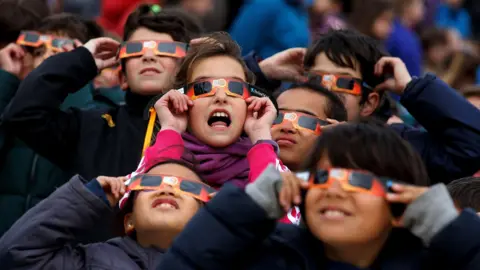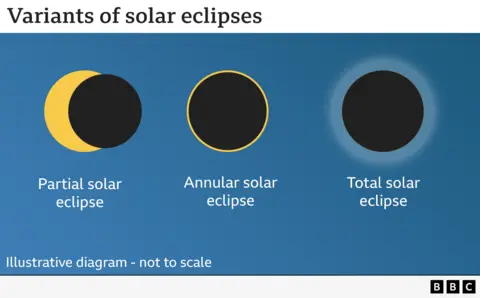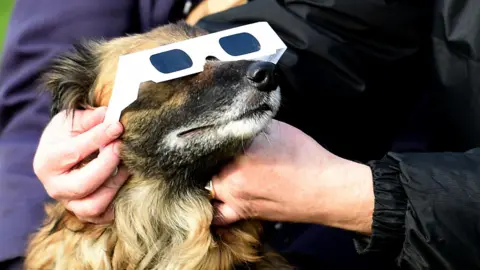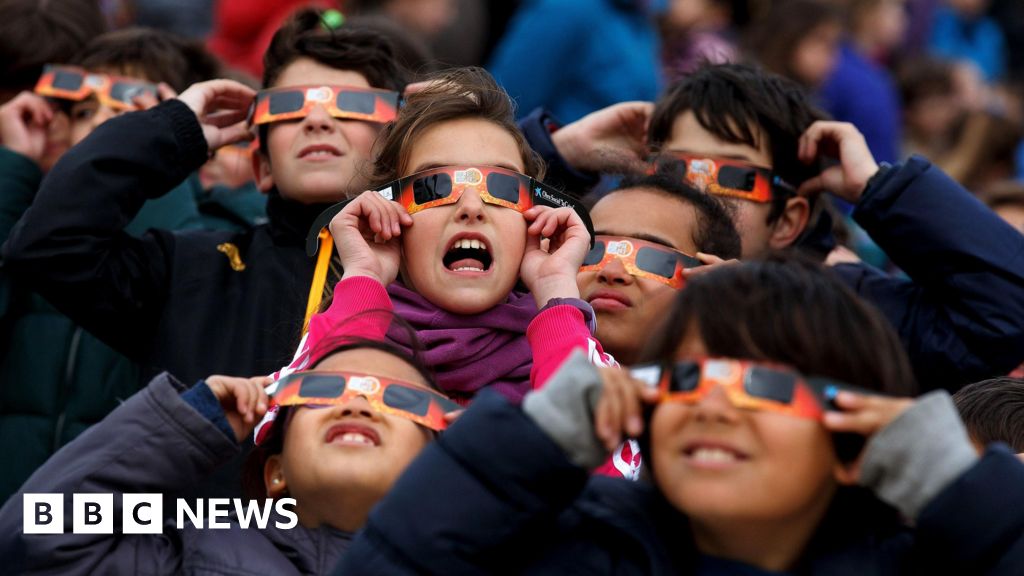BBC Climate & Science
 Getty Images
Getty ImagesGet your protective eclipse glasses ready – weather permitting you’ll be able to see the Moon take a ‘bite’ out of the Sun on Saturday morning.
The partial solar eclipse will be visible across the UK. People will have the chance to see the Moon cover about 30 to 50% of the Sun at its peak, with the best chance of clear skies in south-east England, East Anglia and the Midlands.
The eclipse won’t be total anywhere in the world, but northeastern regions of Canada will see up to 92% of the Sun covered.
You must not ever look at the Sun directly, as it can severely damage your eyes, so you will need those special eclipse glasses if you’re going to take a peak.
When and where will the partial eclipse be seen?

This partial eclipse will be visible across Europe, Northwestern Africa, Greenland, Iceland, and parts of the northeastern US and eastern Canada, with varying levels of visibility.
It will begin at 10:07 in the UK and will end at midday.
Some parts of the UK will see more of the Sun covered than others. If you are in the Outer Hebrides, for example, you’ll see up to 47% of the Sun obscured, while Dover in southeast England will only see about 28% of it covered.
Eclipse times will vary slightly depending on where you are, so use Time and Date to check exact times in your location.
“This is an excellent chance to go out, look – safely – and to be able to see the movement of the solar system for yourself,” said said Anna Gammon-Ross, Senior Planetarium Astronomer at Royal Museums Greenwich.
“It’s such a wonderful way to just connect to everything happening and, and see it all in action.”
What Is a solar eclipse?

A solar eclipse occurs when the Moon moves between the Sun and Earth, blocking some or all the Sun’s light.
There are different types of solar eclipses, depending on how much of the Sun is obscured.
- Partial solar eclipse – The Moon partially covers the Sun, leaving a crescent-shaped section of the Sun visible.
- Annular solar eclipse – The Moon is directly in front of the Sun but appears smaller, leaving a thin, bright ring of sunlight around its edges.
- Total solar eclipse – The Moon completely covers the Sun, revealing a glowing outer atmosphere called the corona.
When and where is the next solar eclipse?
Skywatchers in the UK will be treated to another partial solar eclipse on August 12, 2026, when the Arctic, eastern Greenland, Iceland, and northern Spain will experience a rarer total eclipse.
The UK won’t witness another full solar eclipse for another 65 years, until September 23, 2090, according to the Royal Observatory in Greenwich.
The UK’s last total solar eclipse took place in 1999, with Cornwall being the only location in the country to experience the event in its totality, drawing thousands of people to the region.
How to watch a solar eclipse safely
 Getty Images
Getty ImagesIt’s important to ensure you’re taking the proper precautions to view this event safely.
Even during a partial eclipse, it is never safe to look directly at the Sun with the naked eye as it can cause eye damage, including blindness.
Solar eclipse glasses are specifically designed to filter out harmful UV rays and reduce the intense brightness of the Sun, making it safe to look directly at the eclipse.
Normal sunglasses won’t work because they don’t block enough light to protect your eyes from the Sun’s extreme intensity.
“If you blocked as much sunlight with your sunglasses as eclipse glasses do, you wouldn’t be able to see where you were going!” said Miss Gammon-Ross.
If you don’t have access to eclipse glasses, you can create a simple pinhole camera with just two sheets of cardboard or even use a colander to project the Sun’s image safely onto the ground.
Local astronomical societies may host eclipse events with telescopes fitted with solar filters.
The Royal Observatory in Greenwich will be hosting a live stream of the March 2025 solar eclipse, allowing viewers across the UK to experience the event online in real-time.
Looking at the Sun without protection can cause permanent retinal damage and blindness, even after just a few seconds of exposure.
Will the skies be clear enough to see it?
The weather on Saturday morning could be a little tricky for some and the chances of seeing the eclipse vary markedly depending on where in the UK you are.
The best of the clear skies are likely to be found in south-east England, East Anglia and the Midlands. A little high cloud is possible but this should not spoil the view too much.
In Wales, as well as northern and western parts of England, the chances are a little lower. While there will be some clear spells cloud amounts are forecast to increase during the morning.
The weather is likely to be problematic for sky gazers in Scotland and Northern Ireland with thick cloud and outbreaks of rain, especially in the north and west.
Additional reporting by Ben Rich, BBC Weather




